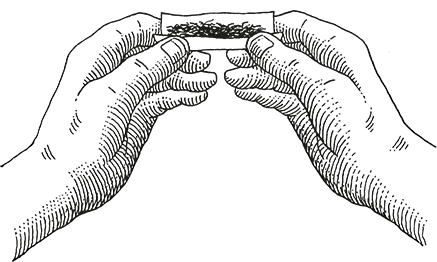The history of man and tobacco is several thousand years old. From stone carvings by the Maya Indians we know they used tobacco for religious ceremonies. Smoke is visible and one of the few things that go from earth into the sky, and therefore smoking tobacco was used as a messenger to the gods. To enhance the ceremony, the tobacco could have been mixed with other plants, like marijuana, which of course improved the contact to the gods, the sightings became clearer and the voice of the gods louder.

Smoking tobacco spread into all parts of South and Middle America, and of course to the islands of the Caribbean Sea. From the time the first man smoked tobacco, thousands of years went past before the first European first handed described the habit of smoking tobacco. It was Christopher Columbus in the year 1492 who first reported the habit of smoking tobacco by the local inhabitants.


Later conquerors encountered tobacco plants everywhere they came, and they started shipping tobacco back to Europe. First tobacco was regarded as a plant of medicine, and Jean Nicot, a physician and ambassador to the queen of France, cured the Queen for her migraines by using tobacco. That was the start of a victory march for tobacco in Europe, In Jean Nicot’s honor the stimulant in tobacco got named after him, and is also today called nicotine.
For King Filip II of Spain the tobacco would turn out to be more valuable than gold. It was named “The Spanish Tobacco”, as the king introduced a monopoly for tobacco trade. It was forbidden to sell tobacco or seeds without the King’s permission and a violation led to a death sentence to the unauthorized trader. Seeds were spread to all Spanish colonies around the world, inclusive the colonies in the Far East. However, the monopoly would very soon come under attack.
The English were also looking for new colonies; however they landed north in what today is called USA. The first colony vanished in 1607 and a second attempt was made. They succeeded in establishing a town in Virginia named Jamestown. The local Powhatan Indians were smoking as well but it was very different from “The Spanish Tobacco”. It had thin leaves, poor burning and was very strong. The English tried to send it back to London, but hardly anyone wanted to buy this tobacco. The settlers tried to produce silk, glass and many other items however they didn’t find a way to sustain a reasonable living standard. This lead to financial hardship, and slowly the idea of giving up the colony became more evident.
Then in 1610 a man called John Rolfe arrived in Jamestown. On his way from London, the ship where he was passenger had a ship wreck on Bermuda. All hands survived but the ship had to be repaired. On Bermuda they found plants of “The Spanish Tobacco and John Rolfe most likely took seeds from these plants, and brought them to Jamestown. In 1611 he planted the seeds in Jamestown, and the crop was a huge success. The next year the first shipment of tobacco was sent from Virginia to London. Not only was the company that sent them to colonize happy, King James I of England was happy as well. The King saved a lot of money because he did not have to buy the tobacco from Spain; instead it came from the English colony in Virginia. The Virginia tobacco was born. Today we are all reminded of King James I every day, as he was the inventor of taxation of tobacco.


One way of spreading the habit of smoking was made by the generals under the big European wars. They found out that a soldier who smoked could walk a little further and he would need less food, so giving the soldiers tobacco became part of the ration, and smoking became normal among soldiers.
Back in Virginia it was the start of prospering times. More, many more settlers came to Virginia and they needed more land for growing tobacco. The land slowly spread north, south and west until coming into what is called Kentucky today. The soil was different from Virginia and the tobacco leaves grew thicker and bigger than the Virginia tobacco. Later on the Kentucky farmers started to smoke the leaves and Dark Fired Kentucky tobacco was born.
A farmer from Ohio took some seeds from Kentucky and brought them back to Ohio. Again the soil and weather was different, so the new plants developed thinner leaves than the Kentucky tobacco, but thicker leaves than the Virginia tobacco. In the year 1864 this farmer cultivated a new tobacco variation, the White Burley (the Burley we use today) tobacco was born.
In the 1840s and 1850s a lot of experimentation took place in curing Virginia tobacco, and slowly the Flue Curing was a fact. Due to the rather hard and quick flue curing, the tobacco kept the natural sugar and for the smoker it meant a natural sweet taste. The Bright Virginia was born.
In the Krim war around 1856 the English and French soldiers noticed their counterparts smoking tobacco in thin paper tubes. Both the English and the French adopted the idea and soon hand rolling cigarette factories began producing cigarettes in England and France. The real breakthrough for cigarettes came with the introduction of the Bonsack automatic cigarette machine in Durham, North Carolina. With the new machine the production of cigarettes became higher than the demand, so an aggressive advertising for smoking cigarettes began. Since then the cigarette companies haven’t looked back.


So, what was the difference between “The Spanish Tobacco” and the tobacco the English found in Jamestown? “The Spanish Tobacco” was the plant Nicotiana Tabacum and the English found the Nicotiana Rustica. The latter is much higher in nicotine and is not suitable for smoking in a pipe or cigarette. So overall the Nicotiana Tabacum won the tobacco competition and is today common for smoking, no matter if we smoke pipe, cigarette or cigar.
Is Nicotiana Rustica then completely out of business? Not at all. Today it is used for Swedish Snus and chew bags.

The history of man and tobacco is several thousand years old. From stone carvings by the Maya Indians we know they used tobacco for religious ceremonies. Smoke is visible and one of the few things that go from earth into the sky, smoking tobacco was used as the messenger to the gods. To enhance the ceremony, the tobacco could have been mixed with other plants, like marihuana, which of course improved the contact to the gods, the sightings became clearer and the voice of the gods louder.

Smoking tobacco spread into all parts of south- and middle America, and of course to the islands of the Caribbean Sea. From the time the first man smoked tobacco, thousands of years went past before the first European first handed described the habit of smoking tobacco. It was Christopher Columbus in the year 1492 who first reported the habit of smoking tobacco by the local inhabitants.

Later conquerors encountered tobacco plants everywhere they came, and they started shipping tobacco back to Europe. First tobacco was regarded as a plant of medicine, and Jean Nicot, a physician and ambassador to the queen of France, cured the Queen for her migraines by using tobacco. That was the start of a victory march for tobacco in Europe, In Jean Nicot’s honor the stimulant in tobacco got named after him, and is also today called nicotine.
For King Filip 2 of Spain the tobacco would turn out to be more valuable than gold. It was named “The Spanish Tobacco”, as the king introduced a monopoly for tobacco trade. It was forbidden to sell tobacco or seeds without the king’s permission and a violation led to a death sentence to the unauthorized trader. Seeds were spread to all Spanish colonies around the world, inclusive the colonies in the Far East. However, the monopoly was very soon be under attack.

The English were also looking for new colonies; however they landed north in what today is called USA. The first colony vanished in 1607 and a second attempt was made. They succeeded in establishing a town in Virginia named Jamestown. The local Powhatan Indians were smoking as well but it was very different from “The Spanish Tobacco”. It had thin leaves, poor burning and was very strong. The English tried to send it back to London, but hardly anyone wanted to buy this tobacco. The settlers tried to produce silk, glass and many other items however they didn’t find a way to sustain a reasonable living standard. This lead to financial hardship, and slowly the idea of giving up the colony became more evident.
Then in 1610 a man called John Rolfe arrived in Jamestown. On his way from London, the ship where he was passenger had a ship wreck on Bermuda. All hands survived but the ship had to be repaired. On Bermuda they found plants of “The Spanish Tobacco and John Rolfe most likely took seeds from these plants, and brought them to Jamestown. In 1611 he planted the seeds in Jamestown, and the crop was a huge success. The next year the first shipment of tobacco was sent from Virginia to London. Not only was the company that sent them to colonize happy, King James I of England was happy as well. The king saved a lot of money because he did not have to buy the tobacco from Spain; instead it came from the English colony in Virginia. The Virginia tobacco was born. Today we are all reminded of King James I every day, as he was the inventor of taxation of tobacco.

One way of spreading the habit of smoking was made by the generals under the big European wars. They found out that a soldier who smoked could walk a little further and he would need less food, so giving the soldiers tobacco became part of the ration, and smoking became normal among soldiers.
Back in Virginia it was the start of prospering times. More, many more settlers came to Virginia and they needed more land for growing tobacco. The land slowly spread north, south and west until coming into what is called Kentucky today. The soil was different from Virginia and the tobacco leaves grew thicker and bigger than the Virginia tobacco. Later on the Kentucky farmers started to smoke the leaves and Dark Fired Kentucky tobacco was born.
A farmer from Ohio took some seeds from Kentucky and brought them back to Ohio. Again the soil and weather was different, so the new plants developed thinner leaves than the Kentucky tobacco, but thicker leaves than the Virginia tobacco. In the year 1864 this farmer cultivated a new tobacco variation, the White Burley (the Burley we use today) tobacco was born.

In the 1840ties and 50ties a lot of experimentation took place in curing Virginia tobacco, and slowly the Flue Curing was a fact. Due to the rather hard and quick flue curing, the tobacco kept the natural sugar and for the smoker it meant a natural sweet taste. The Bright Virginia was born.
In the Krim war around 1856 the English and French soldiers noticed their counterparts smoking tobacco in thin paper tubes. Both the English and the French adopted the idea and soon hand rolling cigarette factories began producing cigarettes in England and France. The real breakthrough for cigarettes came with the introduction of the Bonsack automatic cigarette machine in Durham, North Carolina. With the new machine the production of cigarettes became higher than the demand, so an aggressive advertising for smoking cigarettes began. Since then the cigarette companies haven’t’ looked back.

So, what was the difference between “The Spanish Tobacco” and the tobacco the English found in Jamestown? “The Spanish Tobacco” was the plant Nicotiana Tabacum and the English found the Nicotiana Rustica. The latter is much higher in nicotine and are not suitable for smoking in a pipe or cigarette. So overall the Nicotiana Tabacum won the tobacco competition and is today common for smoking, no matter if we smoke pipe, cigarette or cigar.
Is Nicotiana Rustica then completely out of business? Not at all, today it is used for Swedish Snus and chew bags.

